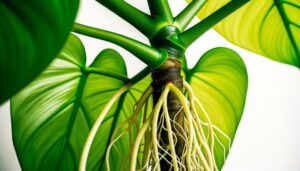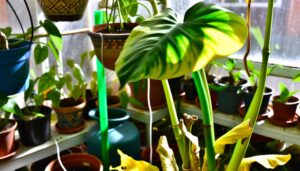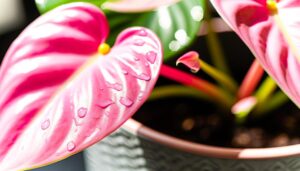What Is a Philodendron Melanochrysum Black Gold?
Philodendron Melanochrysum Black Gold, native to the tropical rainforests of Colombia and Ecuador, features velvety, dark leaves with enchanting golden venation. This aroid flourishes in high humidity (60-80%), dappled sunlight, and temperatures of 65-80°F (18-27°C).
Ideal care includes consistent moisture, well-draining soil rich in organic matter, and regular pruning for health and aesthetics. Fertilize with a balanced, water-soluble solution and maintain a soil pH of 5.5-6.5.
Common pests include spider mites, aphids, and mealybugs, controlled by neem oil. Regular propagation via stem cuttings is recommended.
Continue to explore to discover more specifics.
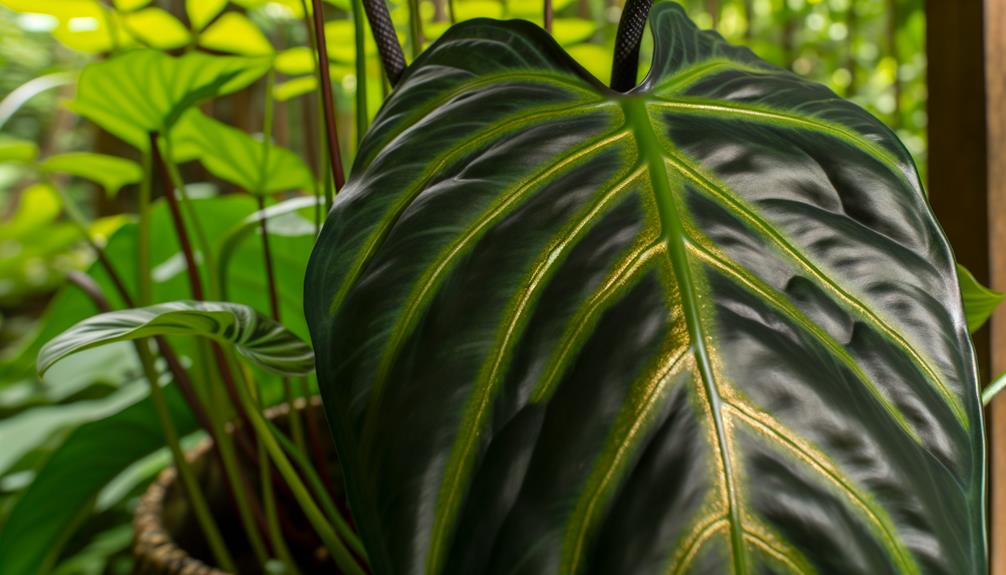
Key Takeaways
- Philodendron Melanochrysum Black Gold is a tropical plant native to Colombia and Ecuador.
- It features unique, velvety dark green leaves with golden veining.
- Thrives in high humidity and bright, indirect light.
- Requires consistent moisture, well-draining soil, and regular fertilization.
- Common issues include pests like spider mites, aphids, and mealybugs.
Origins and History

Philodendron melanochrysum, often referred to as Black Gold, comes from the tropical rainforests of Colombia and Ecuador, where it thrives in the humid, shaded understory. These regions offer an ideal environment characterized by high humidity and dappled sunlight, vital for its growth.
Discovered in the early 19th century, this species quickly attracted attention for its unique foliage and adaptability to indoor conditions. Cultivators aiming to replicate its natural habitat should maintain moderate to high humidity levels, indirect light, and well-draining soil rich in organic matter.
Additionally, maintaining temperatures between 65-80°F (18-27°C) is essential for healthy growth. Regular misting and the use of humidifiers can help achieve the necessary moisture levels, thereby promoting optimal development in domestic settings.
Distinctive Features
Characterized by its velvety, heart-shaped leaves adorned with striking gold veining, the Philodendron melanochrysum exhibits a unique aesthetic appeal that sets it apart from other species.
The leaves, which can grow up to 60 centimeters in length, possess a deep green to blackish hue, creating a dramatic contrast with the golden venation.
This species is a climbing epiphyte, often displaying aerial roots that aid in nutrient absorption and support. The plant's petioles are notably elongated, allowing for prime leaf display.
Its growth habit and foliage texture demand careful handling to prevent damage. Regular pruning is advised to maintain its shape and vigor.
The Philodendron melanochrysum's intricate features make it a prized specimen among horticulturists and indoor plant enthusiasts.
Ideal Growing Conditions
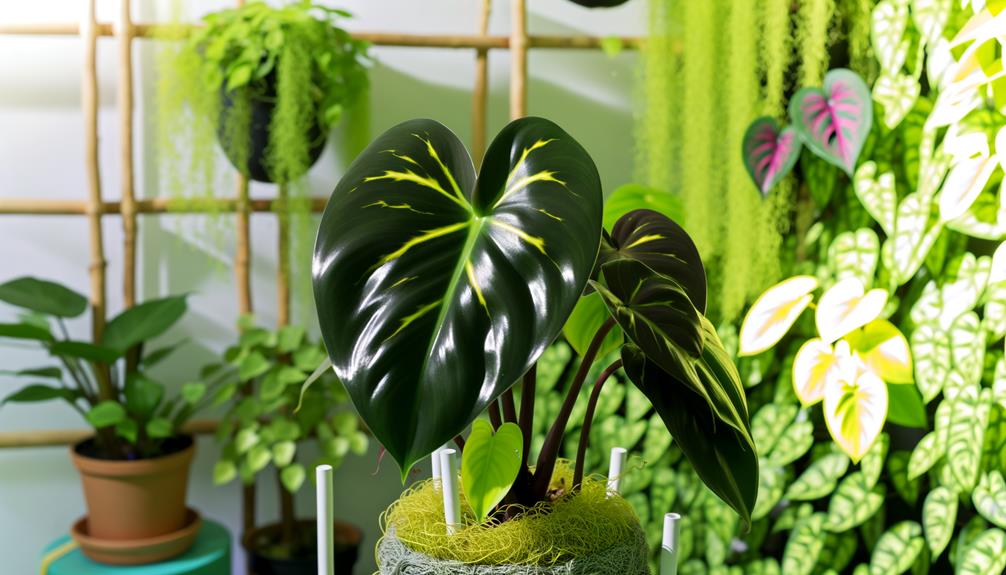
To cultivate Philodendron melanochrysum Black Gold successfully, it is crucial to replicate its native tropical rainforest environment. This involves maintaining high humidity levels, consistent warmth, and indirect light. This plant thrives under specific conditions that mimic its natural habitat.
- Humidity: Aim for a relative humidity level of 60-80%. Utilizing a humidifier or placing the plant on a pebble tray filled with water can achieve this.
- Temperature: Maintain temperatures between 65-80°F (18-27°C). Avoid exposing the plant to cold drafts or sudden temperature fluctuations.
- Light: Provide bright, indirect light. Direct sunlight can scorch the leaves, while too little light may hinder growth. Use sheer curtains to diffuse sunlight if necessary.
Adhering to these parameters promotes ideal growth and health.
Watering Needs
Optimizing proper hydration is vital to the health of Philodendron melanochrysum Black Gold, requiring a careful balance to avoid both underwatering and overwatering.
This plant thrives in consistently moist, but not waterlogged, conditions. To achieve this, water the plant when the top inch of the soil feels dry to the touch. Use room temperature, filtered water to prevent root shock and minimize the risk of introducing harmful chemicals.
It is essential to optimize adequate drainage to prevent root rot. During the growing season, typically spring and summer, the plant may require more frequent watering. Conversely, reduce watering frequency in the dormant months of fall and winter.
Regularly monitor the plant to adjust watering as necessary, promoting ideal growth.
Soil and Fertilizer

To maximize growth, Philodendron melanochrysum Black Gold requires a well-draining soil mix that combines organic matter and aerating components, such as perlite or orchid bark.
This plant thrives with a balanced nutrient profile, necessitating regular fertilization with a high-quality, water-soluble fertilizer.
A fertilizing schedule of bi-monthly applications during the growing season is recommended to sustain its vibrant foliage and overall health.
Ideal Soil Mix
Selecting the best soil mix for Philodendron Melanochrysum Black Gold involves a careful balance of aeration, moisture retention, and nutrient availability to support its unique growth requirements. A well-draining, organic-rich medium is essential to prevent root rot and promote healthy growth.
To achieve this, consider the following components:
- Peat Moss: Enhances moisture retention while providing a stable pH environment conducive to root development.
- Perlite or Orchid Bark: Improves aeration and drainage, preventing waterlogging and ensuring roots receive adequate oxygen.
- Compost or Worm Castings: Supplies essential nutrients and beneficial microorganisms, promoting robust plant health.
A balanced mix incorporating these elements will create an excellent growing environment, facilitating vigorous growth and the unique aesthetic appeal of the Philodendron Melanochrysum Black Gold.
Nutrient Requirements
The ideal nutrient management for Philodendron Melanochrysum Black Gold involves the integration of a balanced soil composition and a regular, appropriate fertilization regimen to support its distinctive growth patterns and foliage development. Best soil should be well-draining with a mix of peat, perlite, and orchid bark to promote aeration and prevent root rot. A balanced, water-soluble fertilizer with an N-P-K ratio of 20-20-20 is recommended to promote strong growth and vibrant foliage. The following table outlines essential soil components and their benefits:
| Component | Function | Proportion |
|---|---|---|
| Peat | Retains moisture | 40% |
| Perlite | Enhances drainage | 30% |
| Orchid Bark | Improves aeration | 30% |
| Vermiculite | Nutrient retention | Optional |
| Compost | Organic nutrients | Optional |
Regular monitoring of soil pH (5.5-6.5) is vital for nutrient uptake.
Fertilizing Schedule
Maintaining a top fertilizing schedule is necessary to guarantee that Philodendron Melanochrysum Black Gold receives the nutrients required for robust growth and vibrant foliage. This entails understanding the plant's soil preferences and fertilizer needs. Best cultivation involves:
- Soil Composition: Utilize a well-draining aroid mix enriched with organic matter, ensuring adequate aeration and moisture retention.
- Fertilization Frequency: Apply a balanced, water-soluble fertilizer every four weeks during the growing season (spring and summer). Reduce frequency to bi-monthly during fall and winter.
- Nutrient Ratio: Select a fertilizer with an N-P-K ratio of 20-20-20 or 10-10-10, ensuring a balanced supply of nitrogen, phosphorus, and potassium, which are essential for leaf development, root growth, and overall plant health.
Adhering to this schedule will enhance plant strength and aesthetics.
Common Pests and Issues
Philodendron Melanochrysum Black Gold can be susceptible to a range of pests and issues that can hinder its best growth.
Effective pest prevention strategies, including regular inspections and maintaining proper humidity levels, are essential to safeguard against infestations.
Identifying common issues such as spider mites, mealybugs, and root rot early, through close monitoring, allows for timely intervention and treatment.
Pest Prevention Strategies
To effectively manage pest prevention for Philodendron Melanochrysum 'Black Gold,' it is crucial to identify common pests such as spider mites, aphids, and mealybugs, which can significantly impact the plant's health.
Implementing a rigorous pest prevention strategy involves:
- Regular Inspection: Conduct weekly examinations of the foliage for any signs of pests. Use a magnifying glass to detect minute insects.
- Environmental Control: Maintain appropriate humidity levels (60-80%) and guarantee proper air circulation to deter spider mites, which thrive in dry conditions.
- Biological and Chemical Interventions: Introduce beneficial insects like ladybugs to control aphids, and apply horticultural oils or insecticidal soaps to manage mealybugs without harming the plant.
These steps are critical for safeguarding the Philodendron's health and longevity.
Identifying Common Issues
Understanding the common issues faced by Philodendron Melanochrysum 'Black Gold' is imperative for ensuring ideal plant health and preventing potential damage. Two prevalent concerns include pest infestations and environmental stress. Common pests such as spider mites, aphids, and mealybugs may colonize the plant, leading to chlorosis and stunted growth. Regular inspection and the application of neem oil or insecticidal soap can mitigate these infestations.
Environmental stressors like inadequate humidity, improper watering, and suboptimal light levels can manifest as leaf yellowing or browning. Maintaining humidity levels above 60%, ensuring well-draining soil, and providing indirect sunlight are critical care measures. Understanding these parameters and implementing proactive care strategies are essential for the thriving growth of Philodendron Melanochrysum 'Black Gold'.
Propagation Tips
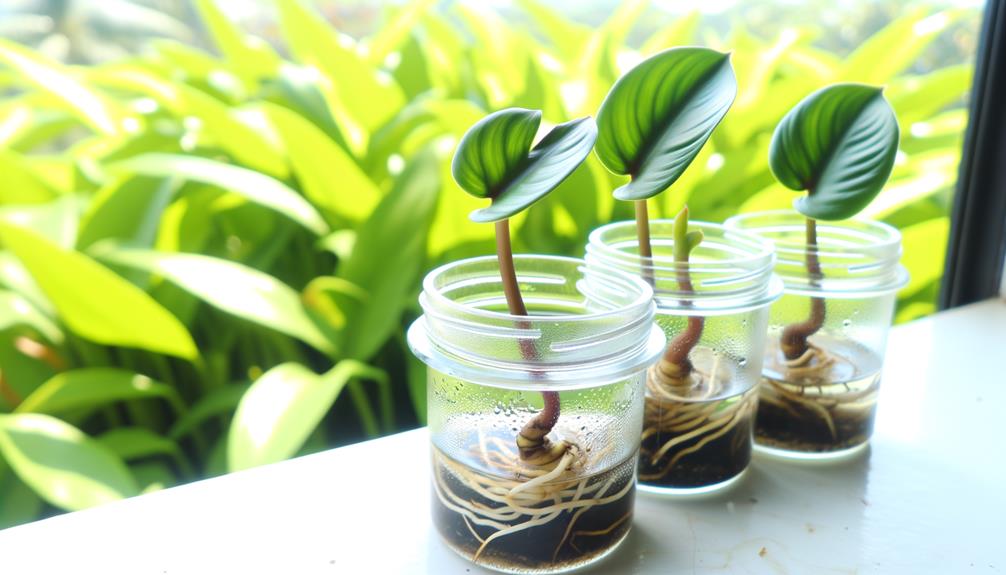
Successful propagation of Philodendron Melanochrysum Black Gold involves selecting a healthy parent plant and utilizing the stem cutting method to achieve the best growth and development.
- Selection of Cutting: Choose a stem with at least two nodes and healthy leaves. The nodes are critical as they contain meristematic tissue essential for root formation.
- Preparation: Use sterilized pruning shears to make a clean cut just below a node. Dip the cut end in rooting hormone to enhance root initiation.
- Planting and Care: Place the cutting in a well-draining potting mix, preferably sphagnum moss or perlite. Maintain high humidity and keep the medium moist but not waterlogged. Provide indirect light to prevent scorching and ensure ideal growth conditions.
Understanding these steps guarantees successful propagation.
Conclusion
To sum up, the Philodendron melanochrysum 'Black Gold' is a captivating plant originating from tropical rainforests. Its unique velvety leaves, necessitating particular growth conditions, highlight the plant's distinct aesthetic charm.
Careful attention to watering, nutrient-rich soil, and diligent pest control is crucial. Though propagation may be intricate, it can lead to gratifying outcomes.
As the saying goes, 'Preventive care guarantees the plant's lasting health and beauty, rendering it a valuable addition to any collection.


